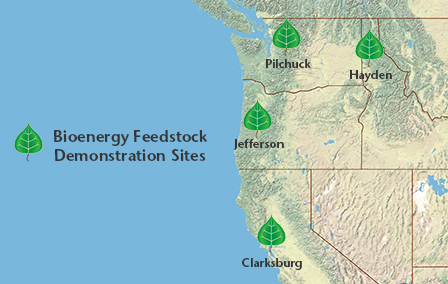
Overview
The AHB Feedstock Team investigated how to produce renewable and readily-available hardwood feedstocks for biofuel and biochemical industries in the Pacific Northwest. The Feedstock Team researched hybrid poplars as the primary feedstock grown as short-rotation perennial woody crops, which will be harvested on two to three year rotations.
Task
Determine how to best produce short-rotation hybrid poplar as a biofuel feedstock in the Pacific Northwest.
Research Outcomes
- Developed four demonstration sites in the Pacific Northwest (ranging in size from 50 – 95 acres).
- Demonstrated establishment, maintenance, and removal (i.e., restoration) of “poplar for biomass” plantations.
- Refined growing and harvesting technologies.
- Quantified and compared biomass growth and yield for two cutting cycles.
- Evaluated production costs.
- Evaluated different poplar varieties to find top biomass producers, and assessed Leaf Area Index as a selection method.
- Studied impacts of planting density (i.e., stool spacing).
- Studied benefits of interplanting with alder (a nitrogen-fixer).
- Identified microbes that improve nutrient/water availability and increase disease resistance in poplar.
- Developed a genomic-assisted poplar hybridization strategy.
- Developed wildlife management and VOC emission mitigation guidance for biomass plantations.
- Published fact sheets on insect pest management in hybrid poplars (WSU Series).
- Engineered sterile hybrid poplar varieties.
- Explored the potential to use near infrared spectroscopy to identify pest-resistant poplar hybrids
Publications produced by the Feedstock Team can be found here.

